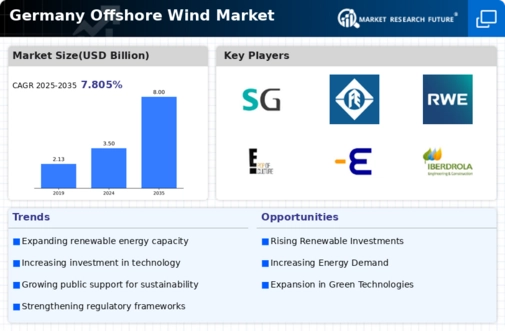Investment and Financing Opportunities
The offshore wind market in Germany is witnessing a surge in investment and financing opportunities, driven by both public and private sector initiatives. The German government has committed to substantial funding for renewable energy projects, with plans to allocate €9 billion for offshore wind development by 2030. This financial backing is complemented by increasing interest from private investors, including institutional funds and energy companies, who are recognizing the long-term potential of offshore wind. The combination of government support and private investment is likely to create a favorable environment for project financing, enabling the development of new offshore wind farms. As a result, the offshore wind market may experience accelerated growth, with more projects coming online in the coming years.
Regulatory Support and Policy Framework
The offshore wind market in Germany benefits from robust regulatory support and a comprehensive policy framework. The German government has set ambitious targets for renewable energy, aiming for 65% of electricity consumption to come from renewable sources by 2030. This commitment includes specific provisions for offshore wind, which is expected to contribute significantly to this goal. The Federal Maritime and Hydrographic Agency (BSH) plays a crucial role in facilitating the development of offshore wind projects by streamlining permitting processes. Additionally, the Renewable Energy Sources Act (EEG) provides financial incentives, such as feed-in tariffs, which enhance the economic viability of offshore wind projects. As a result, the regulatory environment appears conducive to attracting investments and fostering growth in the offshore wind market, potentially leading to an increase in installed capacity and technological innovation.
Technological Innovations and Cost Reductions
Technological advancements are transforming the offshore wind market in Germany, leading to increased efficiency and reduced costs. Innovations in turbine design, such as larger rotor diameters and higher capacity factors, are enabling projects to generate more energy at lower costs. The average cost of offshore wind energy has decreased significantly, with estimates suggesting a reduction of over 50% in the last decade. This trend is likely to continue as research and development efforts focus on improving turbine performance and reducing installation costs. Furthermore, advancements in floating wind technology may open new areas for development, particularly in deeper waters. As these technologies mature, they could enhance the competitiveness of the offshore wind market, making it a more attractive option for investors and stakeholders alike.
Rising Energy Demand and Decarbonization Goals
Germany's commitment to decarbonization and the rising demand for clean energy are pivotal drivers for the offshore wind market. The country aims to achieve carbon neutrality by 2045, necessitating a substantial increase in renewable energy generation. The offshore wind market is poised to play a vital role in meeting this demand, as it offers a reliable and scalable source of energy. According to recent data, the offshore wind capacity in Germany is projected to reach 20 GW by 2030, reflecting a significant increase from previous years. This growth is driven by both domestic energy needs and the European Union's broader climate objectives. The urgency to transition away from fossil fuels further propels investments in offshore wind infrastructure, thereby enhancing the market's potential for expansion and innovation.
Public Awareness and Environmental Considerations
Public awareness and environmental considerations are increasingly influencing the offshore wind market in Germany. As the population becomes more conscious of climate change and the need for sustainable energy solutions, support for offshore wind projects is growing. Surveys indicate that a significant majority of the German public favors the expansion of renewable energy sources, including offshore wind. Additionally, environmental assessments are becoming more rigorous, ensuring that projects are developed with minimal impact on marine ecosystems. This heightened awareness may lead to more community engagement and support for offshore wind initiatives, ultimately facilitating smoother project approvals and implementation. The interplay between public sentiment and environmental stewardship is likely to shape the future landscape of the offshore wind market.






















Leave a Comment